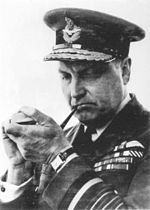Sholto Douglas, 1st Baron Douglas of Kirtleside: Difference between revisions
→References: addcats |
GrahamBould (talk | contribs) +awards |
||
| Line 12: | Line 12: | ||
|commands= |
|commands= |
||
|battles=[[World War I]], [[World War II]] |
|battles=[[World War I]], [[World War II]] |
||
|awards=[[Military Cross]]<br>[[Distinguished Flying Cross (United Kingdom)|Distinguished Flying Cross]]. |
|||
}} |
}} |
||
Revision as of 17:03, 22 March 2008
William Sholto Douglas | |
|---|---|
 Sir Sholto Douglas | |
| Allegiance | |
| Service/ | |
| Years of service | 1914 – 1947 |
| Rank | Marshal of the Royal Air Force |
| Battles/wars | World War I, World War II |
| Awards | Military Cross Distinguished Flying Cross. |
Marshal of the Royal Air Force William Sholto Douglas, 1st Baron Douglas of Kirtleside, GCB, MC, DFC, RAF (December 23, 1893 - October 29, 1969) was a senior figure in the Royal Air Force up to and during World War II.
Douglas was born in Headington, Oxfordshire, the son of Professor Robert Langton Douglas and his wife Margaret Jane (née Cannon). He was educated at Tonbridge School and Lincoln College, Oxford. At the outbreak of World War I he was commissioned in the Royal Field Artillery. In 1915, following a disagreement with his Commanding Officer, he transferred to the Royal Flying Corps joining 2 Squadron as an observer. He soon trained as a pilot and earned Royal Aero Club certificate No 1301. By September 1917 he was a major and Commanding Officer of 84 Squadron. The squadron became one of the premier RFC/RAF fighter units in 1918 and by the end of the war Douglas had been awarded a Military Cross and a Distinguished Flying Cross.
Post-war he worked briefly for Handley Page and as a commercial pilot before rejoining the Royal Air Force in 1920 after a chance meeting with Hugh Trenchard. He became an RAF instructor before being appointed to the Air Ministry in 1936. He was raised to Air Vice Marshal in 1938 and made assistant chief of air staff.
During World War II he and Trafford Leigh-Mallory clashed with the head of 11 Group, Keith Park, and the head of Fighter Command, Hugh Dowding, over strategy in the Battle of Britain. Douglas argued for a more aggressive engagement with a 'Big Wing' strategy. When Charles Portal was made Chief of the Air Staff in October 1940 he supported Douglas, moving Park and Dowding and appointing Douglas to replace Dowding as head of Fighter Command.
In 1942 Douglas was replaced at Fighter Command by Leigh-Mallory and was transferred to Egypt, becoming commander of the RAF in the Middle East in 1943. Douglas returned to England in 1944 to head Coastal Command during the invasion of Normandy.
Douglas was well rewarded after the war. He was the first commander of the British Occupation Zone in Germany and in 1946 he was promoted to Marshal of the Royal Air Force, one of only two RAF officers ever to hold this rank without serving as Chief of the Air Staff. In 1948 he was raised to the peerage as Baron Douglas of Kirtleside, of Dornock in the County of Dumfries. Douglas retired in 1948 and became chairman of BEA in 1949 a post he retained until 1964.
References
- Air of Authority - A History of RAF Organisation - MRAF Douglas
- Probert, H. (1991). High Commanders of the Royal Air Force. HMSO. ISBN 0-11-772635-4
- www.thepeerage.com
- 1893 births
- 1969 deaths
- Alumni of Lincoln College, Oxford
- Barons in the Peerage of the United Kingdom
- Royal Artillery officers
- British Army personnel of World War I
- Royal Air Force personnel of World War I
- Royal Flying Corps officers
- Royal Air Force World War II air marshals
- Marshals of the Royal Air Force
- Recipients of the Military Cross
- Recipients of the Distinguished Flying Cross
